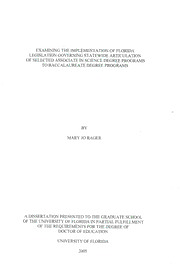
Examining the implementation of Florida Legislation governing statewide articulation of selected associate in science degree programs to baccalaureate degree programs PDF
Preview Examining the implementation of Florida Legislation governing statewide articulation of selected associate in science degree programs to baccalaureate degree programs
EXAMININGTHEIMPLEMENTATIONOFFLORIDA LEGISLATIONGOVERNINGSTATEWIDEARTICULATION OFSELECTEDASSOCIATEINSCIENCEDEGREEPROGRAMS TOBACCALAUREATEDEGREEPROGRAMS BY MARYJORAGER ADISSERTATIONPRESENTEDTOTHEGRADUATESCHOOL OFTHEUNIVERSITYOFFLORIDAINPARTIALFULFILLMENT OFTHEREQUIREMENTSFORTHEDEGREEOF DOCTOROFEDUCATION UNIVERSITYOFFLORIDA 2005 ACKNOWLEDGMENTS Iamespeciallygratefultomyfriendsandfamilywhoprovidedsupportand encouragementthroughoutmygraduateprogram. Theirlove,patience,and understandinghaveinspiredmetoreachmygoals,whileenduringlife'schallengesalong theway. ThewonderfulsupportIreceivedfrommyfriendsandcolleaguesatLake- SumterCommunityCollegehasbeeninstrumentalinhelpingmetocompletemy programofstudy. Theirencouragement,expertise,time,andmoralsupporthelped tremendouslyinmyeffortstobalanceworkresponsibilitieswiththeprofessionaland personalsidesoflife. Specialthanksareconveyedtomycommitteechair.Dr.DaleF.Campbell,forhis encouragement,support,andconfidenceinmethroughoutmygraduatestudies. His guidanceinchallengingmeto"stepoutofmycomfortzone"hasenabledmetogrow personallyandprofessionally. 1amalsothankfultomycommitteemembers: Dr.David Honeyman,forsharinghisexpertiseandsupport;Dr.LynnLeverty,forher encouragementandinsight;andmynewestcommitteemember.Dr.LawrenceTyree,for hiswillingnesstoworkwithmeasIconcludemyproject. Also,specialthanksare extendedtoDr.JamesWattenbarger,whoinspiredmetopursuemygraduatestudiesand servedasawonderfulrolemodelformanystudents. IalsoconveymyappreciationtothededicatededucatorsandASdegreegraduates whoparticipatedinthisstudy. Theygraciouslycommittedtheirtimeandprovided valuableinsighttothestudyastheysharedtheirexperiencesandperceptionswithme. I ii amalsothankfultomyfellowgraduatestudentswhohavebeensupportiveand encouragingthroughouttheprocess. Thecompletionofthisprojecthasbeenpossiblethroughthesupportofan incrediblegroupoffriends. MydeepestappreciationgoestoKathyNesbit,GailJohnson, MargieFarmer,BonnieHolloway,DonnaSarber,DebraDabney,andBrandyZiesemer, forithasbeenthroughtheirimmeasurablesupport,patience,andinspirationthatIhave beenabletosurvivethisincrediblejourney. iii TABLEOFCONTENTS page ACKNOWLEDGMENTS ii LISTOFTABLES vi LISTOFFIGURES vii ABSTRACT viii CHAPTER 1 INTRODUCTION 1 StatementoftheProblem 2 PurposeoftheStudy 3 ResearchQuestions 4 Definitions 4 DesignoftheStudy 5 Methods 6 LimitationsoftheStudy 6 OutlineoftheStudy 7 2 REVIEWOFTHELITERATURE 8 HistoricalPerspective 8 TransferCurriculum 10 TheTransferStudent 13 ArticulationPolicesandPractices 15 ArticulationPoliciesinFlorida 16 StatewideArticulationofAS-BSPrograms 18 BarrierstoArticulation 20 Summary 23 3 METHODOLOGY 25 PurposeoftheStudy 25 ResearchQuestions 26 RationaleandMethodology 26 ResearchMethods 28 Summary 31 iv 4 GROUNDEDTHEORYFINDINGS 33 PurposeoftheStudy 33 ProcessandCategories 35 EducationalAdministrators'Perspectives 39 Open-CodingCategories 40 ASTransferStudents 54 Summary 62 5 SUMMARY,CONCLUSIONS,ANDRECOMMENDATIONS 64 SummaryoftheStudy 65 Methodology 65 ReviewofFindings 66 Conclusions 72 RecommendationsforFutureResearch 73 APPENDIX INTERVIEWGUIDE 75 REFERENCES 77 BIOGRAPHICALSKETCH 81 V LISTOFTABLES m& Table 4-1 Open-codingcategorieswithpropertiesanddimensionalizedexamples 42 4-2 Open-codi—ngcategorieswithpropertiesanddimensionalized properties students 55 4-3 ASdegreegraduatestransferringtoastateuniversity 61 5-1 Comparisonoffactorsaffectingthedevelopmentandimplementationof statewidearticulationofselectedAS-baccalaureatedegreeprograms 69 vi LISTOFFIGURES Figure ESge 4-1 Flowofactivitiesinconductingagroundedtheorystudy 36 4-2 Theoreticalmodeloffactorsleadingtothedevelopmentandimplementation ofstatewideAS-BSarticulation 63 vii AbstractofDissertationPresentedtotheGraduateSchool oftheUniversityofFloridainPartialFulfillmentofthe RequirementsfortheDegreeofDoctorofEducation EXAMININGTHEIMPLEMENTATIONOFFLORIDA LEGISLATIONGOVERNINGSTATEWIDEARTICULATION OFSELECTEDASSOCIATEINSCIENCEDEGREEPROGRAMS TOBACCALAUREATEDEGREEPROGRAMS By MaryJoRager May2005 Chair: DaleF.Campbell MajorDepartment: EducationalLeadership,PolicyandFoundations Sincetheearly1970s,policymakersandresearchershaveexaminedarticulation andtransferpoliciesinhighereducationinstitutionsthroughoutthenation. Asaresult ofenrollmentgrowthinpostsecondaryinstitutions,shrinkingstatebudgets,andlimited educationresources,publicpressurehasdrivenStateBoardsofEducationtoaddress issuesrelatedtoseamlessarticulationandmaximumaccessinpostsecondaryinstitutions. Seamlessarticulationhas,andcontinuestobe,atopicofinterestandstudyforeducators andlegislatorsonregional,state,andnationallevels. AlthoughastatewidearticulationagreementfortransferringAssociateinArts degreeprogramtobaccalaureatedegreeprogramsatFloridapublicuniversitieshasbeen ineffectfordecades,astatewidearticulationagreementofselectedAssociateinScience degreeprogramstobaccalaureatedegreeprogramshasonlybeenineffectsince1998. ThepurposeofourstudywastoconductananalysisofFloridalegislationrelatedto viii statewidearticulationofselectedAssociateinSciencedegreeprogramstobaccalaureate degreeprogramsinFloridacommunitycollegesandstateuniversities. ThecentralquestionframingthestudywasWhatfactorsledtothedevelopment andimplementationoflegislationinFloridatoadoptstatewidearticulationagreements forselectedAS-baccalaureatedegreeprograms? Thisbroadquestionwasrefinedand focused,asvariousperspectivesofstudentsandeducatorswerecomparedthrough groundedtheorytechniques,tobuildtheunderlyingtheory. Open,axialcodingwasused tointerpretandorganizethedata. Throughthisprocess,thetheoreticalmodelofthe factorsleadingtoimplementationofthestatewidearticulationlegislationemerged. Thesefactorsincludededucationaccess,articulationprocesses,excesshoursandcost, curriculumissues,andASdegreeprogramsofhighinterest. Factorsshapedbythe educationalcontextincludedcollaboration,facultyinvolvement,timeline,andoverall benefittothestudents,resultinginoutcomesthatincludedrevisedcareereducation programs,approvedstatewidearticulationofselectedAS-baccalaureateprograms,and theimpactonASdegreetransferrates. Thetransferfunctionofthecommunitycollegeplaysanimportantroleinhigher education,affectingtheeducationalqualityofitsprogramsandaccessopportunitiesfor itsstudents. BecausethestatewideAS-baccalaureatearticulationagreementisrelatively new,researchfindingsonimplementationandoutcomesofthearticulationlegislation mayleadtoadditionalfollow-upstudiesontheeffectivenessofthesearticulationpolicies andbaccalaureatedegreeattainment. ix CHAPTER 1 INTRODUCTION Over30yearsago,stateinvolvementinthetransferandarticulationprocessin highereducationwasverylimited(Robertson&Frier,1996). Americaneducation, however,hasundergonemuchscrutinyandcriticalreviewduringthepast3decades. Withshrinkingstatebudgets,publicpressureforgreateraccountability,andobligations ofstatestoprovideeducationalopportunitiesfortheircitizenry,theneedforeducational reformwasexpressedbypolicymakers,businessandeducationleaders,andresearchers. Theneedforreformwastoourgenttodelegatethisresponsibilitytoadhoc,accidental, orvoluntarygroups.Asaresult,manystatelegislaturesbeganmandatingthe strengtheningofacademicprograms(Bender,1990;Robertson&Frier,1996). Asameansofstrengtheningtheacademicprogramsofhighereducation institutions,statespromotedthetransferandarticulationbetween2-yearand4-year institutionstohelpincreasesystemicefficiencyandeffectiveness(Ignash&Townsend, 2000). Studiesonthecharacteristicsandtransferproblemsofjuniorcollegestudents wereinitiatedinthe1950sunderthedirectionoftheJointCommitteeonJuniorand SeniorCollegesandcontinuedinthe1960s,notablywithLelandMedsker'sworkon transferstudentperformance,retention,problems,andfacultyattitudes(Kintzer,1996). Sincethen,transferguidelines,articulationagreements,andstate-levelpolicieshavebeen wellstudiedbyBender,Kintzer,Knoell,andWattenbarger(Ignash&Townsend,2000). 1
